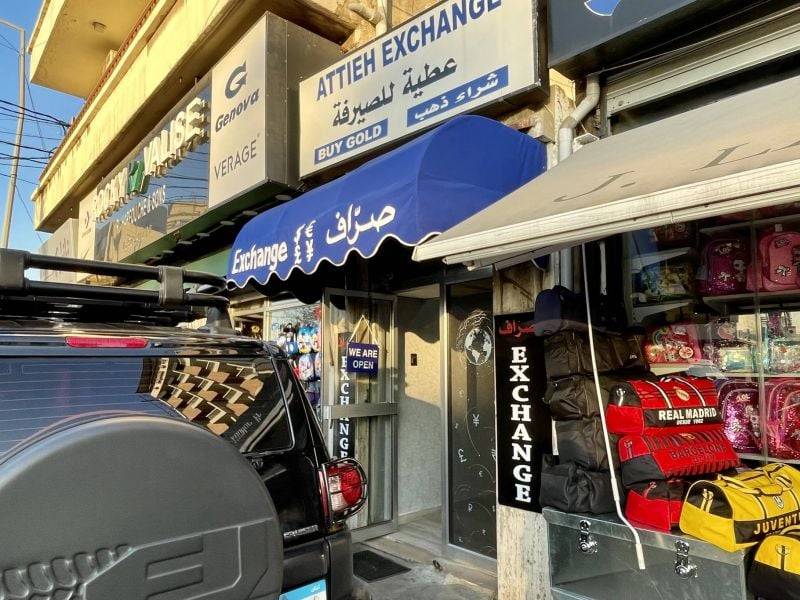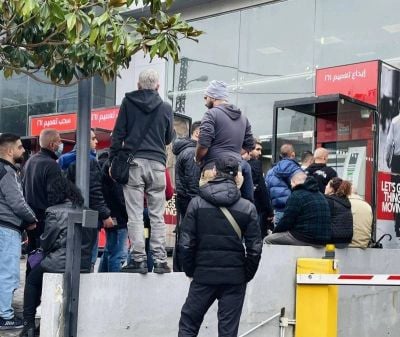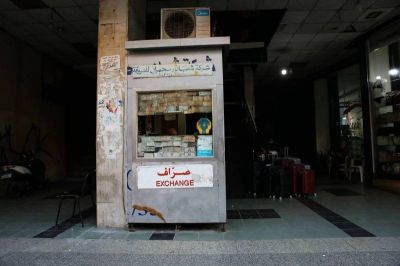
A money exchange shop in Hazmieh. (Credit: Philippe Hage Boutros/L'Orient-Le Jour)
The lira-to-dollar exchange rate saw a new phase of strong fluctuations on the first working day following the long Christmas weekend, which marked a holiday for bank employees — including Banque du Liban. Many money changers, however, opened their doors on Monday.
While it had been sinking at record levels for the past 10 days, successively passing the bars of LL44,000 and LL47,000 to the dollar, the lira finally began to rise hesitantly on Dec. 27, hovering between LL43,000 and LL45,000 at the end of the day, depending on the money changers and the exchange websites relaying the daily lira-to-dollar rates.
Once again, BDL seems to be at the origin of this turmoil.
Shortly before the market changed course, BDL issued two press releases — the second clarifying the first — to announce two exceptional measures concerning its own exchange platform, Sayrafa, whose rate is several thousand Lebanese lira lower than the parallel market rate.
The first measure was to suddenly increase the Sayrafa rate, which is usually adjusted every evening during the business week.
The lira-to-dollar exchange rate, set at LL31,200 to the dollar Friday night, was raised to LL38,000 at around 11:00 on Tuesday Dec. 27 — an unprecedented jump since the platform was launched in its current version in May 2021.
‘Until further notice’
The second measure announced the lifting of all buying and selling limits for “individuals and companies” at banks “until further notice.” In its second statement, the BDL clarified that such transactions can be completed in banks until 5 p.m. on every business day until Jan. 31.
A bank employee told L’Orient-Le Jour on condition of anonymity that she was notified that she had to stay at work until 5 p.m. starting [Dec. 27] until the end of the week, instead of the usual early afternoon.
“The banks need some time to organize themselves and especially to fix the commissions they will take on each transaction,” explained another banking source, who is also not authorized to speak to the press.
The operations concerned are those related to the mechanism of Circular No. 161, which since Dec. 16, 2021, allows depositors in lira-denominated accounts, whose value has collapsed on the market (more than 96 percent depreciation since the beginning of the crisis in 2019), to convert and then withdraw small amounts of “fresh dollars” each month at the Sayrafa rate.
These operations were subject to two separate limits: one was the limit on operations that could be carried out by converting “bank dollars” into lira before converting them back into dollars, which are restricted by the conversion and withdrawal limits specific to each bank.
There was also a limit on the amount of cash in lira that each customer can deposit directly with their bank to exchange for dollars at the Sayrafa rate (the limits were set at a maximum of $400, which varied according to banks).
Fourth episode
According to the same banking source, BDL hopes to achieve two objectives: to reduce losses related to the gap between the market rate and that of Sayrafa, which has recently exceeded LL15,000, and to absorb the lira in circulation on the market or deposited in banks (LL74.8 trillion circulated outside the BDL in mid-December) by injecting more dollars via Circular No. 161.
This is the fourth time this year that BDL plays its part in a recurring scenario that begins with a sustained increase in the rate until it reaches a peak, followed by a correction bringing the same rate to a level well below the peak. Each time, BDL intervention comes as a tipping point.
In mid-January 2022, the lira-to-dollar exchange rate fell from more than LL33,000 to the dollar to less than LL24,000.
At the end of May, the lira nearly exceeded LL40,000 to the dollar after several days of inflation, before falling back to around LL30,000 within a few hours.
Finally, in mid-October, the lira briefly exceeded LL40,000 to the dollar, only to increase by LL5,000.
In this fourth episode, the fall was not as swift but still caught some stockbrokers off guard.
One money changer in Beirut, for instance, complained that he lost several hundred dollars because of the sudden fluctuation.
Another, also in Beirut, set the rate at which he would sell dollars at LL44,500 while buying them back at LL1,500 less — three times the difference he usually charged.
Also in Beirut, a third money changer told L’Orient-Le Jour said he was trading at "LL39,500" on Tuesday morning, while another denounced “Riad Salameh's game” in the market.
Some news sites also relayed a video showing an altercation between two money changers in Chtoura, in the Bekaa Valley).
Finally, if the drop in the market rate is to be reflected in lira prices, assuming that traders play along, the rise of the Sayrafa rate could result in an increase of more than 20 percent in mobile telecom prices, which have been calculated since July 1 in dollars converted at the platform rate (instead of the former official peg of LL1,507.5 to the dollar).
Another medium-term consequence is the electricity bills that will be collected starting in February.
The new electricity tariffs, which apply to subscribers’ consumption as of Nov. 1, are also now calculated in dollars and then converted to the Sayrafa rate.
The only consolation is that employees who feared that they would have to calculate their taxable income in 2022 using this rate, which would have greatly increased their taxes for that year, have been granted a reprieve, as the Finance Ministry has finally decided to modify its initial decision at this level.
This article was originally published in French at L’Orient-Le Jour. Translation by Sahar Ghoussoub.


